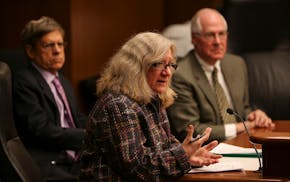Opinion editor's note: Strib Voices publishes a mix of commentary online and in print each day. To contribute, click here.
•••
After Gov. Tim Walz recently rolled out a major sales tax reform, a retired colleague with deep tax policy expertise recommended what I hoped was some light background reading.
The link provided took me to a 1985 report issued during former Gov. Rudy Perpich's administration. Volume 1 of the Latimer Tax Study Commission clocked in at 395 pages, Volume 2 at 462 pages.
For readers who don't want to dig into dusty tomes, here's the relevance: There's a long history of pushing to lower Minnesota's sales tax rate and broaden it, specifically by applying it to more services. Reasons include reducing state revenue volatility. And to expand the base to reduce the sales tax's "regressivity," a term meaning it falls harder on the poor than on the rich.
The 1985 recommendations ought to sound familiar to those following 2025 state politics. By proposing to lower the state's sales tax by .075% and broadening it to services to which it currently doesn't apply, Walz is pushing for changes that have been pointed to for decades by various experts and blue-ribbon study groups.
Few state government reforms have as long and admirable a pedigree. Yet changes like this have proved stubbornly elusive, tripping up even determined governors.
A memorable crash-and-burn happened in 2013, when then-Gov. Mark Dayton proposed an ambitious sales tax overhaul that would have dropped the rate from 6.875% to 5.5% but applied the tax more widely. Among those wielding the fatal buzz saws to Dayton's plan: Republican legislators and the state's business community. The latter mainly objected to something that the Walz plan does not do — imposing the sales tax on business-to-business services, such as legal and accounting.
Thanks to my recent historical reading and other research, I've begun thinking of modernizing the state's sales tax as a good idea whose time never seems to come. That back story doesn't bode well for Walz's latest attempt. Still, his reasons for pushing this are logical and bear examination.
Some important details about Walz's plan: He's proposing lowering the state's effective sales tax from 6.875% to 6.8%. And broadening it to reflect today's more service-oriented economy.
While business-to-business services would continue to be exempt, some consumer services not currently subject to the state sales tax would be added. This would include many consumer services provided by lawyers, brokerages, accountants and bankers. A notable exception: accounting fees for Minnesotans seeking to claim the state's child tax credit. Other consumer service exemptions would apply to Legal Aid services and bank overdrafts.
In addition to leaving out business-to-business services, Walz's proposal is less ambitious than Dayton's in another way. It is projected to bring in a net revenue increase of $205 million in the 2026-27 biennium. Dayton's would have generated "a net revenue increase of $2.1 billion in the FY 2014-15 biennium," according to a 2013 analysis.
Though Walz's plan may be comparatively modest, the governor and his Revenue Commissioner Paul Marquart have a daunting challenge ahead of them persuading legislators. Further complicating this is the Minnesota House dysfunction.
I recently invited Walz and Marquart to make their pitch.
Marquart went first. He quickly noted the historical support from tax wonks for reforms like this. Their reasoning still applies, he said, and includes state's reliance on revenue streams considered more vulnerable to economic fluctuations, such as income and corporate taxes. And that the current sales tax has too many carve-outs and does not reflect the current era's reliance on consumer services.
Marquart underscored that last concern with an eye-catching data point. "Back when the sales tax in Minnesota was enacted in 1967 ... about 60% of the economy was goods, such as buying a boat, a hammer. And about 40% was services. Well, today that is completely reversed," he said.
Another argument in the reform's favor, according to Marquart, is the calculation that the lower rate will "cut taxes for a lot of people." Probably not by much, since most of us don't utilize a lot of legal and financial services, but still better than nothing.
Walz made a similar point. The impact on him personally if the change passes? A sales tax will be added to the $500 he pays for tax preparation, he said. But the lower rates on other things will likely lessen this.
Walz also said the reform will bolster tax fairness, a claim made by another former governor. "The sales tax hits low-income earners because it's heavily focused on goods over services. Jesse Ventura brought this up and others have said that, but why is there a tax on tree trimming but not banking services or a trust fund or whatever?"
As for the why-now question, Walz argued that "It becomes more urgent now because for the first time, and state economists have made clear that this is going to happen, as have national economists, the changing behavior post-COVID and going into the future are [that] services will outpace goods going forward, which leads to a deficit of revenue."
An interview with Republican tax wonk Rep. Greg Davids, R-Preston, made clear the heavy lift ahead at the Capitol. To his credit, Davids wants to hear more and invited Walz and Marquart to make their case in person. But Davids also repeatedly underscored his deep discomfort with raising additional revenue.
I reached out to Dayton, the last governor who attempted major sales tax reform, and asked if he had any advice for Walz. His email reply: "As expected, our proposal was strongly opposed by the business community, who influenced most legislative Republicans and some DFLers to oppose us. So it met its demise! Reinforcing my axiom that 'Everyone is for change, as long as it doesn't happen to them!' "
That doesn't inspire confidence in the 2025 push. But it's still a worthy effort, one that hopefully will pave the way to finally modernize the state's antiquated sales tax system.

Fierce but compassionate mental health advocate will be missed
Burcum: 'Big Beautiful Bill' takes hatchet to health care
Burcum: 'Why would we make it harder to get help' for addiction?
!["Republicans want to overturn this newfound eligibility [for undocumented immigrants to enroll in MinnesotaCare], which was passed by DFL majorities i](https://arc.stimg.co/startribunemedia/XZLGO62KH5G6DHR55ER5IECZAY.jpg?h=91&w=145&fit=crop&bg=999&crop=faces)
Burcum: Don't rush the decision on undocumented immigrant health coverage


